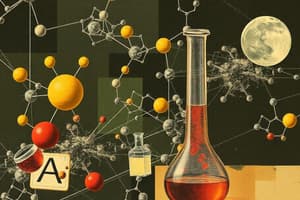Podcast
Questions and Answers
Relaciona los siguientes componentes subatómicos con sus características:
Relaciona los siguientes componentes subatómicos con sus características:
Protones = Cargado positivamente Neutrones = No tienen carga eléctrica Electrones = Cargado negativamente Núcleo del átomo = Contiene protones y neutrones
Asocia los siguientes términos con su descripción adecuada:
Asocia los siguientes términos con su descripción adecuada:
Moléculas = Formadas por la unión de dos o más átomos Compuestos = Resultado de la combinación química de diferentes tipos de átomos Enlaces covalentes = Se forman entre electrones de valencia para lograr configuraciones estables Propiedades distintivas = Características de una sustancia compuesta que difieren de sus componentes
Vincula los siguientes conceptos con su definición correcta:
Vincula los siguientes conceptos con su definición correcta:
Número atómico = Cantidad de protones en un átomo Capas electrónicas = Region donde orbitan los electrones alrededor del núcleo atómico Estabilidad electrónica = Objetivo de los enlaces covalentes para lograr configuraciones estables Elemento químico = Sustancia que contiene un único tipo de átomos con el mismo número atómico
Relaciona los siguientes elementos químicos con su número atómico correspondiente:
Relaciona los siguientes elementos químicos con su número atómico correspondiente:
Asocia los siguientes conceptos con su explicación acertada:
Asocia los siguientes conceptos con su explicación acertada:
Relaciona los siguientes conceptos con su descripción correspondiente:
Relaciona los siguientes conceptos con su descripción correspondiente:
Asocia los siguientes elementos con su ejemplo representativo de enlace específico:
Asocia los siguientes elementos con su ejemplo representativo de enlace específico:
Relaciona los siguientes términos con su función en las interacciones químicas:
Relaciona los siguientes términos con su función en las interacciones químicas:
Asocia los siguientes conceptos con su contribución a la formación de nuevas sustancias:
Asocia los siguientes conceptos con su contribución a la formación de nuevas sustancias:
Relaciona las siguientes afirmaciones con su correspondiente categoría en la interacción molecular:
Relaciona las siguientes afirmaciones con su correspondiente categoría en la interacción molecular:
Flashcards
Atom
Atom
The smallest unit of matter maintaining its chemical identity, consisting of protons, neutrons, and electrons.
Proton
Proton
A positively charged particle found in the nucleus of an atom, determining the atomic number.
Neutron
Neutron
A neutral particle in the nucleus of an atom, contributing to atomic mass but not charge.
Electron
Electron
Signup and view all the flashcards
Molecule
Molecule
Signup and view all the flashcards
Compound
Compound
Signup and view all the flashcards
Ionic Bond
Ionic Bond
Signup and view all the flashcards
Covalent Bond
Covalent Bond
Signup and view all the flashcards
Ion
Ion
Signup and view all the flashcards
Valence Electrons
Valence Electrons
Signup and view all the flashcards
Study Notes
Unraveling Chemistry's Basics: Atoms, Molecules, and Ions
Chemistry is a vast and multifaceted discipline that explores matter and its transformations, delving into the fundamental nature of elements, compounds, and reactions. To understand this science from its roots, we will navigate through some of the most crucial concepts – atoms, molecules, and ions.
Atoms – Building Blocks of Everything
Atoms are the smallest units of matter that maintain their chemical identity. They consist of three primary components: protons, neutrons, and electrons. Protons have a positive charge (+1), neutrons carry no electric charge, while electrons hold a negative (-1) charge. An atom's nucleus contains both protons and neutrons; electrons orbit around it in shells called energy levels. Each element has a unique number of protons determining its atomic number, which distinguishes one element from another.
Molecules & Compounds – Combinations of Atoms
Molecules are formed when two or more atoms bond together, forming covalent bonds. These bonds occur between valence electrons to achieve stable electron configurations. A compound results from chemically combining two or more different types of atoms in fixed proportions, creating a substance with distinct properties quite unlike those of the constituents. For instance, water consists of hydrogen and oxygen atoms, bound by covalent bonds, resulting in H₂O molecules.
Two main categories characterize molecular interactions – ionic and covalent bonds:
- Ionic Bonds - Formed between metal and nonmetal atoms due to the transfer of electrons between them, leaving behind positively charged metal ions and negatively charged nonmetal ions. Sodium chloride, NaCl, exemplifies such a bond, where sodium loses one electron and becomes a Na⁺ ion, forming a lattice structure with Cl⁻ ions.
- Covalent Bonds - Result from sharing electrons between adjacent atoms, ensuring all participate in the formation of stable electron arrangements within molecules. Carbon dioxide, CO₂, features double covalent bonds between carbon and each oxygen atom.
Ions – Charged Particles in Solution
When atoms lose or gain electrons, they form ions – particles carrying either a positive or negative charge. Metallic ions generally possess a deficiency of electrons, while nonmetal ions typically gain extra electrons. In solutions, these charged particles can interact electrostatically with other oppositely charged ions, leading to various chemical phenomena like precipitation, solubility rules, and redox reactions.
The study of chemistry involves understanding the behavior of atoms, molecules, and ions, how they combine to create new substances, and uncovering the processes driving change in our surroundings. Despite its abstract concepts, the foundation described here provides a robust framework upon which advanced theories and applications can be built.
Studying That Suits You
Use AI to generate personalized quizzes and flashcards to suit your learning preferences.




